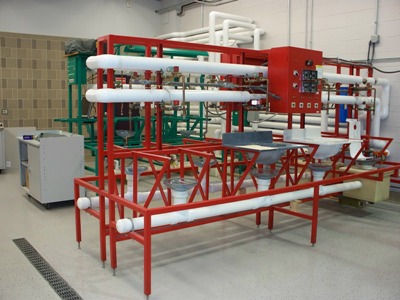Bob Hill, PE
July 25, 2013
Look for the Home Innovation Label
The building codes not only provide requirements for how homes should be assembled structurally, they also often specify criteria that the building materials need to meet. The plumbing codes, for example, require that plastic plumbing fixtures comply with the ANSI Z124 series of standards for plastic plumbing fixtures. These standards were developed beginning in the early 1960s as various plastic materials made their way from other uses into plumbing fixtures, such as gel-coated fiberglass reinforced polyester that was common in boat building being used for fiberglass bath tubs and showers; and cast polymer (i.e., cultured marble), a mixture of resin and fillers, being used for lavatory vanity tops. As the home building industry grew and became more sophisticated, solid surface and acrylic materials also found their way into plastic plumbing fixtures that are now very common in both new homes and remodeling projects.
The ANSI Z124 series of tests were developed to simulate the type of use and abuse that a fixture would encounter in common household use. These tests include structural, impact, thermal cycling, wear and clean ability, stain and chemical resistance, and color fastness. The Z124 standard specifies specific acceptable performance values for each of these test methods. Below is just a brief explanation of two of our accredited test methods for which product manufacturers frequently seek our expertise and abilities.
The thermal cycling test evaluates whether a sink, shower, or tub fixture will crack over time due to repeated changes in water temperature that might create a thermal shock to the system. As part of this protocol, bathroom fixtures are subjected to 500 cycles of water temperature variations from 50F to 150F. The units are inspected at the conclusion of the test for any evidence of cracking. For kitchen sinks, the test protocol requires us to perform 250 cycles with temperature cycling between 70F and 180F, recognizing that kitchen sinks are often subject to exposure to much hotter water than bathroom sinks, such as draining a boiling pot of pasta.

Photo 1: Home Innovation Laboratory Set-Up for Z124 Thermal Cycling Testing
The wear and clean ability test is designed to demonstrate that a unit can be cleaned repeatedly without damaging the surface appearance. Specimens of each unit are cut out and placed in an abrasion tester that scrubs the surface 10,000 times with a mild abrasive solution using a hog bristle brush. After the scrubbing, the surface coating is checked to make sure it did not wear through. White light reflectance readings are taken on the samples. Standard-specified dirt — yes, that's right, ANSI Z124 specifies exactly what constitutes "standard dirt" and how it should be prepared — is applied to the surface and allowed to dry for at least an hour. The surface is then cleaned with both typical detergent and the abrasive slurry solution used in the scrub test, and white light reflectance is measured after each. If the surface is damaged due to the scrubbing, the dirt will collect, remain in the surface defects, and reduce the white light reflectance. The standard specifies that the reduction in reflectance can be no more than 5% after the first cleaning and no more than 2% after the second.

Photo 2: Abrasion Testing Machine Uses for Z124 Testing and Certification
The plumbing codes specify that these plumbing products must be labeled as meeting the Z124 standard by a certification agency accredited to ISO Guide 65. Home Innovation Research Labs is accredited to Guide 65 and our certification mark appears on 100s of thousands of units each year as proof of compliance with Z124. If you are a builder or remodeler purchasing or installing any plastic plumbing fixture, be sure to look for our mark for proof of compliance with your code inspectors and peace of mind with your customers. If you are a fixture manufacture, the Home Innovation plumbing products laboratory is well equipped to test and certify your products with a mark that the code officials recognize. If you'd like more information or to visit our laboratories, just let me know.
Back to Top